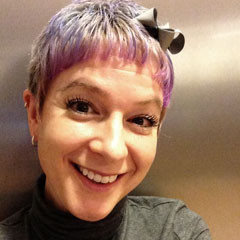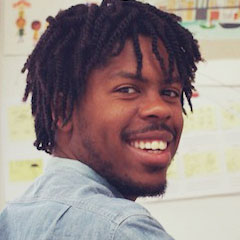New Writer Ame Dyckman

Hi, everyone! I’m so happy to be here today! But I have a confession. When I got the news that I was going to be here today, I wasn’t reading or writing. I was watching “Buffy the Vampire Slayer.” And I was practicing Buffy’s vampire slaying moves.
I was doing this because earlier that week, I’d had a Terrible Thought. One of those self-doubt Terrible Thoughts after a tough writing week. And it was: What if this wonderful being-a-children’s-author thing doesn’t work out?
This was an especially awful Terrible Thought because I’ve only been a children’s author for a short time, but writing for children is what I have always wanted to do.
You can ask my husband, who will tell you I was saying this way back when we first started dating—when we were both in high school. You can ask our daughter, who, as a kindergartener, listened to my dreams of what I wanted to be when I grew up and said, “You can do it, Mommy! You write good stories!”
And you can ask anyone I’ve ever spoken to passionately about the importance of children’s books: kids! And parents! And other authors! And folks behind me in the checkout line! (Yes, I’m one of those people! “I see you’re buying cheese! I have the perfect picture book to go with that!”) And of course, librarians and teachers! HOORAY for librarians and teachers!
That morning, vampire slaying seemed like a promising career with growth opportunities. (But no dental. Yeah, I was surprised, too.) I decided to give it a try anyway. I was training for my new profession when the phone rang.
When I sat down at my computer that night, I didn’t have any ideas. I was tired and grouchy and desperate to go to bed, but I had to write my thought. While I sat there I decided to check out my friend Erin Steadʼs new blog. Erin and I had also worked together at Books of Wonder, and I knew she was finishing up the art for her first book, A Sick Day for Amos McGee. The first photo she had on her blog was of a table in the grass. It was where she worked on nice days.
It was Leila Sales, my brilliant editor of Tea Party Rules. I said “Hi!” and tried to sound like I wasn’t just pretend-staking a TV vampire with a pasta fork from the kitchen. (It’s much harder than it sounds.) And Leila told me I had won this award. And that my genius illustrator, K.G. Campbell, had won an award, too. And that I would be here today talking with you.
For a moment, I couldn’t talk at all. Which, I’m sure you can tell by now never happens. But I was speechless because…it’s the Ezra Jack Keats Award! And his books are magic and a huge inspiration to me. I was speechless because I felt so honored. There are lots of fantastic new writers out there—I know because I read them! I’m a fan first! And I was speechless because that Terrible Thought I’d had was instantly replaced with a Really Positive Thought.
And it was: If I’m lucky enough to have all these fantastic people in my life and now this Selection Committee believing in me, the least I could do is believe, too.
So now my slayer training is purely recreational, not occupational. Because I hope to be a children’s author for a very long time. And I promise to give my writing my best effort. Hope you like it. Thank you.
New Illustrator Christian Robinson
 Thank you to the Ezra Jack Keats Foundation, the de Grummond Collection and The University of Southern Mississippi for this incredible recognition.
Thank you to the Ezra Jack Keats Foundation, the de Grummond Collection and The University of Southern Mississippi for this incredible recognition.
What I love most about the story Linda Ashman shares in Rain! is how simply she reminds us of a very important truth about the power of perception. How we perceive the world—the thoughts, feelings and beliefs we hold on to—shape our experiences and affect the experience of those around us.
The grumpy old man in the story focuses on what he doesn’t like about the rain, and coincidentally or consequently, what he doesn’t like keeps showing up in his day, while opposite, the cheerful young boy is delighted by the wonder of rain and seems to charm and brighten the day of everyone he meets.
James Baldwin said, “The world changes according to the way people see it, and if you alter, even by a millimeter, the way a person looks at reality, then you can change it.” I believe Keats knew this truth, and I imagine that is a part of the reason why he chose to tell a story with a black kid as the main character in The Snowy Day in 1962. Keats was aware that the world of children’s literature at the time needed to alter its reality of what a protagonist could look like.
I’m so grateful to storytellers such as Keats and many others (whose work may not get as much recognition) for sharing stories that more accurately reflect the diverse world we live in. I am honored to be on a path that was created by many socially conscious artists such as Keats who recognized the importance of making sure all children can see a world in books that helps us accept ourselves and others no matter our race, class, gender or sexual orientation.
I know for sure that I could not be here without the support of so many positive forces. Creating books is a team effort, one I’m so humbled to be apart of.
I want to thank my agent and friend Steven Malk for taking a chance on me and for helping me make my dreams come true. I want to thank Linda Ashman for sharing this timeless story with us all. I want to thank Houghton Mifflin for giving me the opportunity to take part in the making of this book.
Thank you to my family and friends. Thank you to my Nana, my grandmother who raised my brother and I. Thank you to my mother, who is in the audience; you may not have had all the resources at the time to be available to us, but I am so grateful for the abundance of love that you had to give. I know it nourishes me to this day.
Lastly, thank you to the friendly universe for allowing me to fulfill a desire placed on my heart. Thank you!
